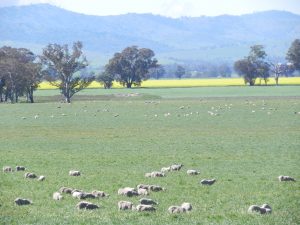
Dennis Donohoe, farm manager with Aminya Pastoral, is a seasoned producer with decades of experience, and his story is a testament to how even minor changes in farming practices can lead to significant improvements in productivity and land health.
The definition of regenerative cropping can be vague, leading to the occasional misuse of the term altogether. In this article, Alexandra de Blas drills down on a definition with RCS Chief of Delivery, David McLean, discovering the importance of soil health and systems that spiral upwards.
 Regenerative cropping is sometimes dismissed as meaning all things to all people, but to David McLean, our Chief of Delivery here at RCS, the answer is more definitive. “Regenerative cropping is about the outcomes you achieve, not the inputs you use.”
Regenerative cropping is sometimes dismissed as meaning all things to all people, but to David McLean, our Chief of Delivery here at RCS, the answer is more definitive. “Regenerative cropping is about the outcomes you achieve, not the inputs you use.”
To achieve regenerative outcomes, you must adopt practices that regenerate healthy soil, regenerate animal and human health, regenerate businesses and regenerate plant health. Together, these elements support thriving communities.
“There is no one silver bullet for regenerative cropping. It is about balancing many things, and fundamentally you need to have your agricultural systems spiralling up towards improved biodiversity and health, rather than spiralling down towards degradation,” says McLean.
In the near future, verification will become increasingly important in regenerative cropping, more so than accreditation. “Again, it’s about outcomes. If you can demonstrate that your soil carbon is increasing or that you’re building natural capital, you’ve got evidence that your farm is regenerating,” McLean said.
“Research shows that many plants are only operating at 11% of their photosynthetic potential, so you can have a paddock full of green stuff that isn’t reaching its potential.”
Promoting biodiversity is central to the success of regenerative cropping, and photosynthesis drives biodiversity.
“Research shows that many plants are only operating at 11% of their photosynthetic potential, so you can have a paddock full of green stuff that isn’t reaching its potential. We are finding that as soil health improves, photosynthetic capacity increases, akin to having more solar panels in a solar farm.”
“Under irrigation, where water is not a limiting factor, it is possible to increase photosynthetic capacity fivefold, in turn increasing yield fivefold. But under dryland conditions, our goal would be to double it,” McLean said.
“The plant knows where it needs to direct its energy, and the healthier the soil, the more the plant partitions energy into production. As soil health improves, the plant directs more carbohydrates into above-ground production and shunts less carbohydrates through its roots to drive soil health repair.”
Another benefit of improving soil health is reduced risk. Regenerating soil results in higher Brix measurements in crops – a measurement of dissolved sugar in the leaves. Two of the many benefits of higher Brix readings are improved frost tolerance and reduced insect predation.
Ran Mitchell, a regenerative cropper west of North Star in NSW, has witnessed this first-hand. “For three days, I watched a thick swarm of plague locusts fly right across my healthy cowpea crop to eat a struggling crop on the property next door. It was quite incredible,” Mitchell said.
If you’re ready to start exploring the principles of regenerative agriculture in more detail, we have courses and workshops designed for all levels and schedules.
Author:

Profitable Paddocks is our educational newsletter sent to your email inbox every quarter.
Click the Bell for the latest blogs.

Dennis Donohoe, farm manager with Aminya Pastoral, is a seasoned producer with decades of experience, and his story is a testament to how even minor changes in farming practices can lead to significant improvements in productivity and land health.
Once you have ownership as to why planning is important, the next ingredient is to work out where and how you will do your planning. When you write something down you change your relationship with the content. I cannot emphasise enough the power of getting your thoughts and plans out of your head onto paper or the computer.
The season in SA and Tassie is particularly tight right now with little or no useful rain since early January and a generally failed 2023 spring prior to that. Right now, across southern Australia and much of the eastern NSW, you won’t need to drive far out into the countryside to see cattle and sheep grazing (and lying on) hay and silage trails lined across paddocks.
Martha Lindstad and partner Robert James are farm managers on ‘Karalee’, Enngonia NSW. Both have travelled different paths to being where they are. Martha is originally from Norway, growing up on a three hectare farm before travelling to New Zealand and eventually the Pilbara in Western Australia. It was here that she saw the benefits of sustainable farming for the country and livestock.
The Prince’s RCS mentor, Raymond Stacey, sees a strong future ahead for Simon and Laura. “The Drought Resilient Soils and Landscapes project is about supporting graziers to manage their country and businesses better,” Raymond said. “I see an operation here where they’re working hard on their planning and putting their plans into action to leave their country, business and people in better shape.”

Join our mailing list
